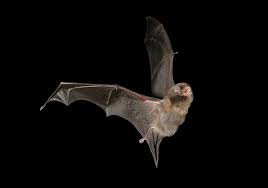
Bats
Featured Animal: June 2015
By Dr. Nicki Frey
As the evenings grow longer, and we spend more time outside during the summer, we often see bats flitting around in the dusk. Those that have swimming pools, or frequent their favorite swimming hole as the sun goes down, will no doubt have a story about bats swooping down to take a drink, inevitably scaring the human swimmers out of the water. We are afraid of bats – because they look strange, we don’t want to get bit, or because of pop culture. But is there any real reason for us to have a healthy fear of bats?
There are 18 species of bats in Utah; all 18 can be found in southern Utah, while 6 species are found mostly in northern Utah, predominantly in the mountainous habitats (UDWR 2015). The largest bat in Utah, the big free-tailed bat (Nyctinomops macrotis) weighs less than 1oz (28 g), about the weight of a small handful of crackers (DePaepe, Messmer & Conover, 2010). Most of the time, bats and humans exist together without much interaction. Potential conflict occurs when bats roost inside attics, crawl spaces, or other structures that place them close to human contact. Sometimes, bats fly into homes at night through open windows, creating a potentially hazardous situation for both the bat and the humans.
Animal bites are nothing to joke about; one can get any number of diseases and infections as a result of getting bit by a wild animal (or a domestic one, for that matter; Conover & Vail, 2015). However, one of the things that makes bat bites potentially dangerous is that many people that have been bit or scratched by a bat never know it. Therefore they don’t seek proper medical attention when they need to.
The danger in getting bit or scratched by a bat is our ability to get rabies from bats. Rabies cannot be transmitted through intact skin, but does enter the body through a bite or scratch. Additionally, mucous from bats can become airborne while they hibernate and inhaled by people that are exploring caves, thereby transmitting the rabies virus (Conover and Vail, 2015). At first, the symptoms of rabies are similar to influenza. Then symptoms follow a progression of hypersensitivity (extremely sensitive to light, air, or touch) and hyperactivity that eventually leads to paralysis and finally death. The symptoms of the virus do not present themselves for at least 10 days, and up to several weeks, possibly even several months. By the time a person is exhibiting the symptoms of rabies, death is likely. Of the 33 cases of rabies in the United States from 2002-2011, fatality was 91% (Conover and Vail, 2015).
While possible, the risk of becoming infected by rabies is low in the western United States, because most people receive vaccinations in time. Of the known rabies cases in the United States from 2002-2011, nearly half were known to be transmitted by a bat bite or scratch (Conover and Vail, 2015). Many bats have been previously exposed to the rabies virus, which indicates that the virus continues to circulate through bat populations. However only about 6% of bats that have been submitted for testing actually had rabies. The problem is that one cannot tell by looking at a bat if it has rabies or not. The Center for Disease Control recommends seeking professional medical treatment for anyone scratched or bitten by a bat regardless of its apparent health (http://www.cdc.gov/rabies/exposure/animals/bats.html).
If you are bitten or scratched by a bat (or any wild mammal) follow these steps:
- Wash the wound immediately with soap, water, and antiviral antiseptic for at least 15 minutes.
- Seek medical attention. Your physician will consult with local public health authorities to determine the appropriate steps to take.
- Often, rabies vaccination may be required. This is a series of 4 doses of rabies vaccine. Since 1980, there have been no documented cases of rabies in the US among patients that have completed this series of vaccinations.
- If you have been bitten or scratched by a bat, the Center for Disease Control recommends the vaccination series.
- Avoid any bat that is active during the day, attacking other animals, unable to fly or resting on the ground.
- Never handle a bat with your bare hands, even if it is behaving normally.
- If you think you might have been scratched or bit, seek prompt medical attention.
- If a bat if found, especially one that is showing signs of illness, around small children or those with an inability to express themselves (i.e. you don’t know if they’ve been bitten or not) seek prompt medical attention.
References
Center for Disease Control [CDC]. (2015). Bats. Retrieved from http://www.cdc.gov/rabies/bats/index.html
Conover, M. R., and R. M. Vail. (2015). Human Diseases from Wildlife. CRC Press: Boca Raton, Florida.
Utah Division of Wildlife Resources [UDWR]. (2015). Vertebrate Animals. Retreived from http://dwrcdc.nr.utah.gov/rsgis2/Search/SearchVerts.asp.
DePaepe, V., T. A. Messmer, and M. R. Conover. 2010. Bats. Retreived from http://digitalcommons.usu.edu/cgi/viewcontent.cgi?article=2009&context=extension_histall.

